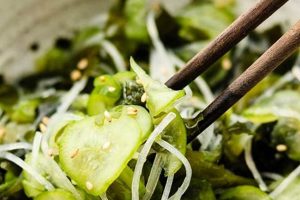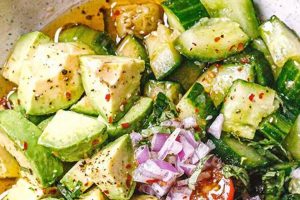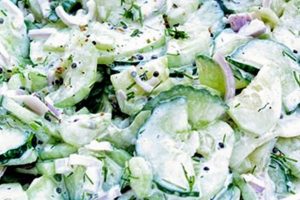A refreshing and vibrant dish, this culinary creation combines the earthy sweetness of beets with the cool crispness of cucumbers. Often enhanced with fresh herbs like dill or mint, and a tangy vinaigrette, variations can include feta cheese, red onion, or toasted nuts for added texture and flavor. A simple preparation might involve roasted or pickled beets, thinly sliced cucumbers, and a lemon-herb dressing.
This combination offers a nutritious and flavorful salad option. Beets are rich in nitrates, which can contribute to improved blood flow and lower blood pressure. Cucumbers provide hydration and are a good source of vitamins K and C. The inclusion of fresh herbs and a light dressing further enhances the nutritional profile while keeping the dish light and palatable, suitable as a side dish or a light lunch. Historically, both beets and cucumbers have been cultivated and enjoyed for centuries, making this a timeless combination.
Further exploration will delve into various preparation methods, ingredient variations, and serving suggestions for creating this versatile and healthful salad. Nutritional information, tips for selecting the freshest produce, and advice on balancing flavors will also be addressed.
Tips for a Perfect Beet and Cucumber Salad
Achieving optimal flavor and texture requires attention to detail in preparation and ingredient selection. The following tips offer guidance for creating a truly exceptional salad.
Tip 1: Roast beets for enhanced sweetness. Roasting beets intensifies their natural sweetness and imparts a subtle smoky flavor. Wrap beets individually in foil and roast until tender, typically 45-60 minutes at 400F (200C).
Tip 2: Balance flavors with acidity. The earthy sweetness of beets benefits from a bright, acidic counterpoint. Lemon juice, red wine vinegar, or apple cider vinegar are excellent choices for the vinaigrette.
Tip 3: Consider pickling or quick-pickling. Pickled beets offer a tangy, vibrant alternative to roasted beets. Quick-pickling thinly sliced beets offers a similar flavor profile in a shorter timeframe.
Tip 4: Salt cucumbers to remove excess moisture. Salting sliced cucumbers draws out excess moisture, preventing a watery salad. Allow salted cucumbers to rest for 15-20 minutes before adding them to the salad.
Tip 5: Embrace fresh herbs. Fresh dill, mint, or parsley complement the flavors of beets and cucumbers beautifully. Chopped chives or tarragon can also add a sophisticated touch.
Tip 6: Add textural contrast. Toasted walnuts, pecans, or sunflower seeds provide a satisfying crunch. Crumbled feta cheese or goat cheese add a creamy element.
Tip 7: Chill before serving. Chilling the salad allows the flavors to meld and enhances the refreshing qualities of the dish.
By following these tips, one can elevate this simple salad to a truly memorable culinary experience. Careful preparation and attention to flavor balance result in a dish that is both healthy and delicious.
These insights provide a foundation for crafting a personalized version of this classic salad. Experimentation with different ingredients and techniques encourages culinary creativity.
1. Ingredient Quality
Ingredient quality significantly impacts the final outcome of a beet and cucumber salad. Choosing fresh, high-quality produce and complementary ingredients elevates this simple dish from ordinary to extraordinary. Subpar ingredients can result in a bland, watery, or otherwise unappetizing salad, regardless of preparation technique.
- Freshness of Produce
Peak-season beets and cucumbers offer the best flavor and texture. Look for firm beets with smooth skins and no signs of bruising or soft spots. Cucumbers should be firm and vibrantly colored. Avoid produce that appears wilted or damaged. Freshness directly correlates with the salad’s vibrancy and overall palatability.
- Sourcing of Ingredients
Whenever possible, sourcing ingredients locally supports regional agriculture and often results in higher-quality produce. Farmers’ markets provide access to freshly harvested vegetables often picked at their peak ripeness. Organic produce, while not essential, can offer another layer of quality assurance. The source of ingredients can influence flavor and nutritional value.
- Complementary Ingredients
The quality of supporting ingredientssuch as herbs, cheese, nuts, and vinaigrette componentsis equally important. Fresh herbs contribute bright, nuanced flavors. High-quality oils and vinegars create a balanced and flavorful dressing. Selecting premium nuts or cheeses further elevates the salad’s complexity. Attention to these details elevates the overall sensory experience.
- Proper Storage
Even high-quality ingredients can deteriorate if not stored properly. Beets and cucumbers should be refrigerated and used within a few days of purchase. Proper storage maintains optimal freshness and prevents spoilage, preserving the intended flavors and textures for the salad.
By prioritizing ingredient quality, one ensures a beet and cucumber salad that is not only visually appealing but also delivers a delightful culinary experience. The interplay of fresh, flavorful components contributes to a truly satisfying and nutritious dish.
2. Flavor Balance
Flavor balance is paramount in a successful beet and cucumber salad recipe. The inherent sweetness of beets requires careful consideration of contrasting and complementary flavors. Without proper balance, the salad can be overly sweet, bland, or lack complexity. A harmonious blend of sweet, tangy, salty, and earthy elements creates a more nuanced and satisfying culinary experience. This balance elevates the simple combination of beets and cucumbers, transforming it into a sophisticated dish.
The interplay of flavors begins with the beets themselves. Roasting intensifies their sweetness, while pickling introduces a tangy dimension. The cool, refreshing cucumber provides a neutral backdrop, allowing the other flavors to shine. The dressing plays a crucial role in balancing these elements. A vinaigrette with a bright acidity, such as lemon juice or vinegar, cuts through the sweetness of the beets. A touch of salt enhances the overall flavor profile, while a hint of sweetness, perhaps from a drizzle of honey or maple syrup, can round out the vinaigrette. Incorporating fresh herbs like dill or mint introduces an herbaceous element that further complements the other flavors. Textural components, such as toasted nuts or crumbled cheese, also contribute to the overall sensory experience, adding a contrasting salty or savory note.
Consider a beet and cucumber salad with roasted beets, thinly sliced cucumbers, crumbled feta cheese, and a lemon-dill vinaigrette. The roasted beets provide sweetness, the cucumbers offer a refreshing contrast, the feta cheese contributes a salty, creamy element, and the lemon-dill vinaigrette provides brightness and herbaceous notes. Each ingredient plays a specific role in creating a harmonious and balanced flavor profile. Failure to balance these elements could result in a salad that is either too sweet, too tart, or simply bland. Achieving this balance is essential for a truly enjoyable and memorable culinary experience.
3. Texture Contrast
Texture contrast significantly contributes to the overall sensory experience of a beet and cucumber salad recipe. A combination of textures elevates this simple salad, creating a more dynamic and satisfying dish. A salad consisting solely of soft, yielding ingredients can feel monotonous. Introducing contrasting textures adds complexity and visual appeal.
- Smooth and Crisp
The primary textural interplay in a beet and cucumber salad comes from the beets and cucumbers themselves. Beets, whether roasted or pickled, offer a smooth, almost velvety texture. Cucumbers, particularly when thinly sliced, provide a refreshing crispness. This foundational contrast forms the basis of the salad’s textural profile.
- Crunchy Additions
Toasted nuts, such as walnuts, pecans, or sunflower seeds, introduce a satisfying crunch. This textural element contrasts with the smoothness of the beets and the crispness of the cucumbers, adding another layer of complexity. The crunch provides an auditory element to the eating experience.
- Creamy Components
Crumbled feta cheese, goat cheese, or a dollop of yogurt or sour cream can introduce a creamy texture. This contrasts with the other textures in the salad, adding richness and a different mouthfeel. The creaminess can also help to bind the other ingredients together.
- Other Textural Elements
Other ingredients can contribute to textural variety. Crispy fried onions, toasted breadcrumbs, or even a sprinkle of sesame seeds can add unexpected textural nuances. These additions further diversify the eating experience, creating a more dynamic interplay of textures.
The strategic use of texture contrast elevates the beet and cucumber salad from a simple side dish to a more engaging culinary experience. The combination of smooth, crisp, crunchy, and creamy elements provides a more satisfying and memorable salad. This interplay of textures is essential for a well-rounded and enjoyable dish.
4. Preparation Methods
Preparation methods significantly influence the flavor profile, texture, and overall presentation of a beet and cucumber salad recipe. Different techniques applied to core ingredients, particularly beets, yield diverse results, impacting the final dish’s sensory experience. Understanding these methods allows for informed choices aligned with desired outcomes, whether emphasizing sweetness, tanginess, or textural contrast.
- Roasting
Roasting beets intensifies their natural sweetness and imparts a subtle smoky char. This method involves wrapping whole, unpeeled beets in foil and baking them until tender. Roasting concentrates the beets’ sugars, resulting in a richer, more complex flavor. The resulting texture is tender and easily incorporated into a salad.
- Pickling
Pickling introduces a tangy, acidic dimension to beets. This method involves submerging cooked, sliced beets in a brine of vinegar, sugar, and spices. Pickling transforms the beets’ flavor profile, adding a vibrant acidity that balances sweetness. The texture remains firm, offering a pleasant contrast to other salad components.
- Boiling/Steaming
Boiling or steaming beets is a quicker cooking method, preserving their earthy flavor while softening their texture. These methods involve cooking beets until tender in boiling water or steam. While less intense than roasting, these techniques offer a simpler approach for incorporating beets into a salad. The resulting texture is soft and easily sliced or diced.
- Raw Preparation
Raw beets offer a crisp, earthy flavor and vibrant color. This method requires thinly slicing or grating raw beets, ideally young and tender ones. Raw preparation preserves the beets natural crispness, offering a distinct textural contrast to other salad ingredients. The flavor is less sweet than roasted or pickled beets.
The chosen preparation method directly impacts the final character of the beet and cucumber salad. Selecting the appropriate technique allows for customization and control over the flavor and texture profile, creating a salad tailored to specific preferences. From the earthy sweetness of roasted beets to the tangy brightness of pickled beets, each method offers a unique contribution to the final dish.
5. Presentation
Presentation plays a crucial role in the overall enjoyment of a beet and cucumber salad recipe. While flavor and texture are paramount, visual appeal significantly enhances the dining experience. A thoughtfully presented salad elevates the perception of the dish, stimulating appetite and creating a sense of occasion. This applies equally to a simple weeknight meal and a more formal setting. Consider the difference between a salad haphazardly tossed into a bowl versus one artfully arranged on a platter. The latter immediately suggests greater care and attention to detail, enhancing the perceived value of the dish.
Several factors contribute to effective salad presentation. Color contrast is key. The vibrant hues of beets, ranging from deep magenta to golden yellow, provide a striking visual foundation. The cool green of cucumbers offers a refreshing counterpoint. Further color can be introduced through other ingredients, such as bright red radishes, deep green herbs, or orange segments. Arrangement is another important consideration. Ingredients can be layered, creating height and visual interest. Sliced beets can be fanned out or arranged in a spiral pattern. Cucumbers can be ribboned or rolled. A sprinkle of chopped herbs or crumbled cheese adds a final flourish. The choice of serving vessel also contributes to the overall presentation. A simple white bowl provides a neutral backdrop that allows the colors of the salad to pop. A rustic wooden bowl adds a touch of warmth and earthiness. Clear glass bowls showcase the layers and textures of the salad.
Ultimately, the goal of presentation is to enhance the sensory experience of the beet and cucumber salad. A visually appealing salad is more enticing and enjoyable to consume. This attention to detail demonstrates care and consideration, elevating a simple salad to a more memorable culinary experience. While elaborate presentation may not be necessary for every occasion, a few simple steps can significantly improve the overall appeal of the dish. This understanding of the importance of presentation allows for a more holistic approach to creating and enjoying a beet and cucumber salad, transforming it from a basic side dish to a truly satisfying culinary creation.
Frequently Asked Questions
This section addresses common inquiries regarding beet and cucumber salad recipes, offering practical advice and clarifying potential uncertainties. Understanding these points contributes to successful preparation and a more enjoyable culinary experience.
Question 1: How can one prevent a watery beet and cucumber salad?
Excess moisture from cucumbers can lead to a watery salad. Salting sliced cucumbers and allowing them to rest for 15-20 minutes draws out excess water. Patting the cucumbers dry before adding them to the salad further minimizes moisture.
Question 2: What are the best methods for cooking beets for this salad?
Roasting intensifies sweetness, while boiling or steaming preserves a more earthy flavor. Pickling adds a tangy dimension. The chosen method depends on individual flavor preferences.
Question 3: Can one prepare this salad in advance?
The salad can be prepared a few hours in advance, but adding the dressing immediately before serving prevents the vegetables from becoming soggy. Storing components separately and combining them just before serving maintains optimal texture and flavor.
Question 4: What dressings complement a beet and cucumber salad?
Vinaigrettes with a bright acidity, such as lemon juice or vinegar, balance the sweetness of beets. Incorporating fresh herbs like dill, mint, or parsley enhances the overall flavor profile.
Question 5: How can one add protein to this salad?
Grilled chicken, crumbled feta cheese, toasted nuts, or chickpeas can boost the protein content while complementing the existing flavors. These additions create a more substantial and satisfying meal.
Question 6: How should beets be stored for optimal freshness?
Store unwashed beets in a perforated plastic bag in the refrigerator crisper drawer for up to two weeks. Remove the greens before storing, as they draw moisture from the roots. Cooked beets can be refrigerated for up to five days.
Addressing these frequently asked questions provides a deeper understanding of beet and cucumber salad preparation. Consideration of these points contributes to a more successful and enjoyable culinary experience.
The following section will explore variations on the classic beet and cucumber salad recipe, expanding on the foundational knowledge provided thus far.
Beet and Cucumber Salad Recipe
Exploration of the beet and cucumber salad recipe reveals a dish offering versatility and nutritional value. Careful ingredient selection, attention to flavor balance, and considered preparation methods contribute to a successful outcome. From the earthy sweetness of roasted beets to the refreshing crispness of cucumbers, the interplay of flavors and textures creates a dynamic culinary experience. Proper presentation further enhances enjoyment, elevating this simple salad to a visually appealing dish.
The beet and cucumber salad recipe provides a foundation for culinary exploration. Adaptation through varied ingredients and techniques allows for personalized interpretations. Continued appreciation of this classic combination ensures its enduring presence in culinary traditions.






